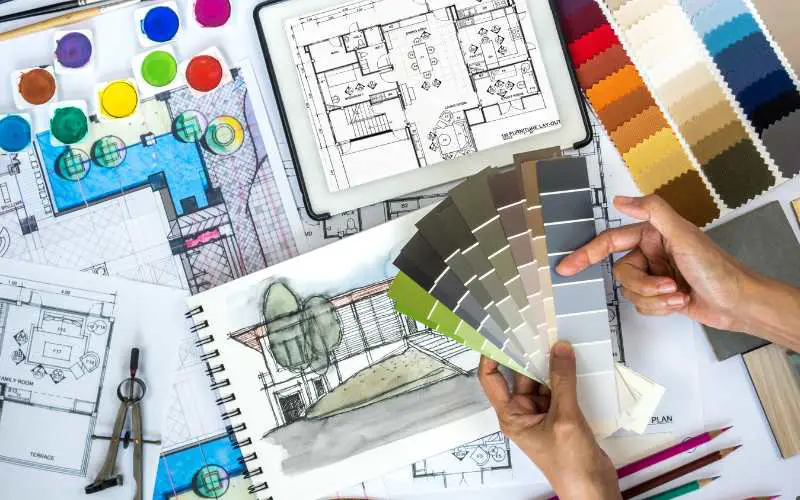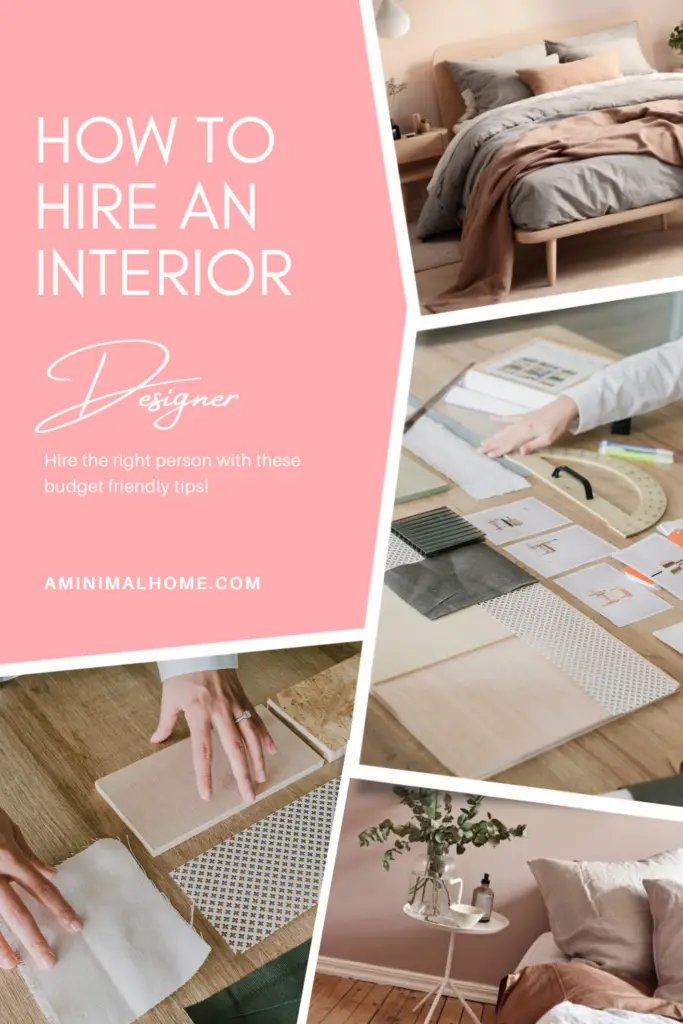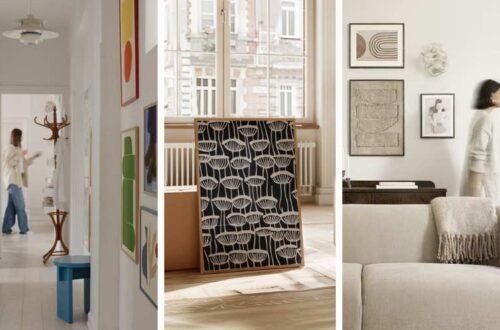
How Much Does An Interior Designer Cost
Share this
Interior designer cost and budget planning tips!
This post contains affiliate links. As an Amazon Associate, I may earn from qualifying purchases at no extra cost to you and it helps keep this little blog afloat. Thanks so much for your support!
No matter the size of our home, we all dream of having a beautiful and functional space where we can live and connect with our loved ones.
At the end of the day, it’s the place where we spend most of our time, and it should be somewhere that inspires and delights us.
Unfortunately, not everyone has the natural ability to visualize how an empty space can be transformed into a harmonious environment.
This is where the expertise of an interior designer becomes invaluable.
These professionals are educated in crafting diverse environments, selecting colors and styles, and choosing furniture and decor that complement the space.
They work according to each individual’s stylistic preferences, transforming spaces with expertise and elegance.
However, before taking the plunge into redesigning your space, it’s crucial to consider the financial aspects of hiring a professional interior designer.
Today, we’ll dive into the costs associated with hiring an interior designer and what you can expect as you make this investment in your living or work environment.
Related: Interior Design Trends
Pin It For Later! 


How Much Does an Interior Designer Cost
When considering hiring an interior designer in the United States, it’s important to note that prices can vary significantly depending on the state or city.
However, if you’re living overseas, these prices can serve as a useful reference for comparing costs in your own country.
On average, hiring an interior designer in the U.S. can range from $2,000 to $12,000.
This might seem quite expensive, but there’s good news! The digital age offers more budget-friendly options, particularly for those with smaller budgets.
Thanks to platforms like Fiverr, you can find interior designers offering services that range from $50 for smaller projects to $500 for high-end projects.
Starting a project with a professional designer online has become both easy and accessible.
One of the greatest advantages of using online interior designer services is the flexibility of scheduling.
You can often agree to pay for the entire project only once it’s fully approved by you. This ensures that you are satisfied with the final outcome before making a full commitment.
Online design projects offer a modern, flexible approach to achieving your dream space without breaking the bank, but physical interior designers also offer benefits like a direct approach with the profesional.
Related: Japandi Bedroom
How Do Interior Designers Charge For Services
Interior designers fees will vary, depending on factors such as the scope of the project, the square foot, the designers working quality and experience level, and the location.
Here are some common methods interior designers use to structure their fees:
1. Hourly Rate
Many interior designers charge by the hour, with rates varying based on experience and the market. Interior designer cost per hour can range from $50 to $500 per hour, or more.
This method is often used for consultations or smaller projects where the scope of work is not clearly defined at the outset.
2. Flat Fee
A flat fee is a fixed amount agreed upon for the entirety of the project. This fee is typically based on the estimated number of hours and resources required to complete the project.
A flat fee can provide clarity and predictability for both the designer and client.
3. Percentage of Overall Project Cost
Some interior designers charge a fee that is a percentage of the total project cost, usually ranging from 10% to 30%.
This method aligns the designer’s compensation with the scale of the project, incentivizing them to stay within budget.
4. Cost-Plus
In a cost-plus agreement, the designer charges the client the actual cost of furnishings, materials, and subcontractor fees plus an additional markup (typically 20% to 35%).
This covers the designer’s time in sourcing and managing these aspects of the project.
5. Per Square Foot
Charging per square foot is common for larger commercial projects, and it involves setting a fixed rate for the total square footage being designed.
This method ensures transparency in pricing relative to the project’s size.
6. Consultation Fee
Some designers charge an initial consultation fee, which may be a standalone cost or credited towards the total project cost if the client decides to proceed.
It’s important for clients to discuss and agree on the fee structure before commencing a project to ensure mutual understanding and avoid surprises.
Related: Minimalist Living Room Design
Frequently Asked Questions About Interior Designers
1. What does an interior designer do?
Interior designers plan, design, and furnish the interiors of residential, commercial, or industrial buildings.
They assess the space, understand client needs, and create functional yet aesthetically pleasing environments by selecting color schemes, furniture, lighting, and materials.
2. How are interior designers different from interior decorators?
Interior designers focus on the structural changes to a space, such as altering layouts and ensuring code compliance with elements like electrical wiring and plumbing.
In contrast, interior decorators focus on the aesthetics, including furniture, paint, and accessories.
3. When should I hire an interior designer?
Consider hiring an interior designer when you are building a new home, undergoing a significant remodel, or simply wanting to update the look and feel of your living or work space.
Early involvement can ensure that your space is optimized for functionality and style.
4. How much does should I expecto to pay for a interior designer?
The cost can vary widely depending on the scope of the project, the designer’s experience, and geographic location.
Some designers charge by the hour, while others may charge a flat fee or a percentage of the project’s total cost.
5. What should I expect during the interior design process?
The process typically involves initial consultations to discuss your needs and budget, followed by the designer presenting concepts and mood boards.
Once a plan is agreed upon, the designer will oversee the implementation, working with contractors and suppliers.
6. Can an interior designer work within my budget?
Yes, a professional interior designer can work within your budget by prioritizing spending, suggesting alternative materials or solutions, and making cost-effective decisions that align with your desired outcomes.
7. Do I need to be involved in the interior design process?
Your level of involvement is up to you. Some clients prefer to be hands-on, while others leave the details to the designer.
Clear communication about your preferences and expectations will help achieve the best results.
8. How do I choose the right interior designer for my project?
Finding the right interior designer is easy.
Request portfolios, check references, and meet with potential designers to ensure they understand your vision and are a good fit for your style and personality.
9. What’s the interior design project scope?
The scope of an interior design project typically encompasses a range of tasks and responsibilities to transform a space aesthetically and functionally.
For example, are you considering a simple bedroom remodel, which typically requires fewer significant changes, or a complete kitchen renovation, involving new installations and surface changes?
Working with an interior designer isn’t complicated, here’s a general step by step you should expect:
- Initial Consultation:
- Discuss your vision, needs, and budget.
- Evaluate the existing space and identify challenges or constraints.
- Concept Development:
- Create initial design concepts and mood boards.
- Develop a color scheme and style direction.
- Space Planning:
- Design floor plans to optimize the use of space.
- Consider furniture layouts, traffic flow, and functionality.
- Design Development:
- Select furnishings, fixtures, and materials.
- Detail architectural elements like moldings, cabinetry, and built-ins.
- Documentation:
- Produce detailed drawings and specifications for contractors.
- Prepare a comprehensive list of materials and furnishings.
- Project Management:
- Coordinate with contractors and vendors.
- Oversee the project timeline and ensure that work aligns with the design plan.
- Budget Management:
- Track expenses and ensure the project stays within budget.
- Manage any adjustments or changes requested by the client.
- Installation and Styling:
- Supervise the installation of furniture and decor.
- Style the completed space to meet the design vision.
- Final Walkthrough and Adjustments:
- Conduct a final review with the designer.
- Address any remaining concerns or last-minute adjustments.
- Post-Project Evaluation: Address any remaining concerns or last-minute adjustments.
10. What’s the size of your space?
The size of the area to be remodeled significantly influences the interior designer cost service. Larger spaces provide more opportunities for creative options, which can impact your final budget.
Pin It For Later! 






